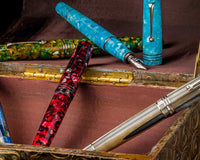For discerning writers, the world of fountain pens is a treasure trove. Two brands consistently rise to the top: Parker and Pilot. Both have rich histories, innovative designs, and loyal followings. But when choosing your perfect pen, which brand reigns supreme?
This guide explores the strengths and considerations of Parker and Pilot fountain pens, helping you navigate this decision.
A Legacy of Excellence: Brand History
Parker, founded in 1888, is a true pioneer. They introduced the iconic safety pen, preventing messy ink spills, and revolutionized the industry with the fountain pen's first self-filling mechanism. Their pens have graced the hands of presidents and literary giants, solidifying their reputation for quality and prestige.
Pilot, established in 1918, may be younger, but its ascent has been no less impressive. It's renowned for its meticulous nib engineering and focus on functionality. Pilot brought affordability and quality to the forefront, making fountain pens accessible to a wider audience.
Writing Experience
The nib, which is the heart of the fountain pen, determines your writing experience. Here's a breakdown of each brand's approach:
Parkers tend to run broader, favored by those who enjoy a bolder and wetter line. They offer a good range of nib sizes, from fine to stub, catering to different writing styles. However, some users find their nibs a tad scratchy compared to Pilots.
Pilot is celebrated for its smooth and consistent nibs. They're known for their fine nib sizes, ideal for detailed writing or those with smaller handwriting. Their nibs are generally praised for offering a delightful and effortless writing experience.
Design and Aesthetics
Both Parker and Pilot offer a spectrum of designs to suit various preferences.
Parker's designs are often classic and elegant. Their higher-end lines, like the Sonnet and Duofold, exude sophistication with precious metal finishes and intricate engravings. Their more affordable pens tend to be simple yet well-made.
Parker Duofold Prestige Chevron Centennial Fountain Pen
Pilot's designs are known for their clean lines and functionality. They offer a wider variety of colorful options, particularly in their Metropolitan and Kakuno lines, appealing to those who enjoy a touch of personality. Their high-end pens, like the Custom series, showcase a more understated elegance.
Filling Mechanisms
Fountain pens come with various filling mechanisms, which can influence how you use them with ink.
Parker offers a mix of cartridge/converter and converter-only pens for their current line up of modern models. Their converters are simple to use, but cartridges may limit ink variety for some users. However, if you can acquire a vintage model, such as the first line of Parker 51s, you can enjoy a vacuum filling system.
Pilot provides a broader selection of filling mechanisms. They offer cartridge/converter, vacuum filling (allowing for larger ink capacity), and even demonstrators (with a transparent body showcasing the ink level). This flexibility allows for greater ink exploration.
Price Points: Finding Your Fit
Both Parker and Pilot cater to a range of budgets.
Parker offers entry-level pens like the Vector for under $20, perfect for beginners. Their higher-end lines, like the Duofold, can reach the thousands, appealing to collectors and luxury pen enthusiasts.
Pilot is known for its exceptional value. Their Metropolitan, a favorite among beginners, is under $20 and offers fantastic performance. Their high-end lines, like the Custom 823, can stay below the $200 mark, providing excellent quality without breaking the bank.
The Final Verdict
There's no single victor in the Parker vs. Pilot battle. The ideal choice depends on your individual needs and preferences.
Choose Parker if: You prefer a broader nib, appreciate classic design, and value brand heritage.
Choose Pilot if: You desire a smooth and fine nib, enjoy a wider range of colors and filling mechanisms, and prioritize affordability without sacrificing quality.
Remember, the nib size and ink choice significantly impact your writing experience. Experiment with different combinations to find your perfect match. Online communities and pen stores are invaluable resources for guidance.
The Bottom Line
Ultimately, the best way to choose is to try both brands! Visit a pen store and hold them in your hand. See which feels more comfortable and balanced. Knowing what to look for in a fountain pen can guide you to your perfect writing companion.
Happy writing!
Written by EndlessPens Blogger Ramona Kabigting











